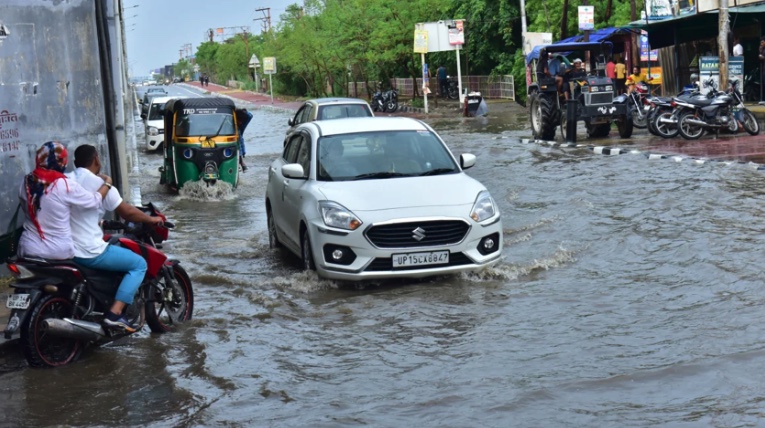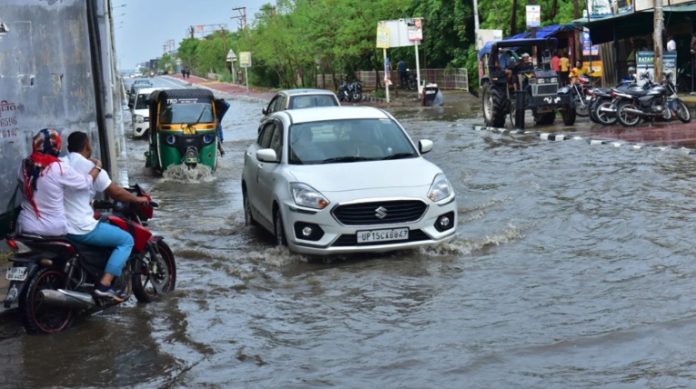ฝนตกหนักกะทันหันทำให้เกิดน้ำท่วมฉับพลันในกรุงเดลี ภายหลังคลื่นความร้อนที่เลวร้ายที่สุดครั้งหนึ่งของเมือง โดยมีอุณหภูมิเกิน 40 องศาเซลเซียส (104 องศาฟาเรนไฮต์) เมื่อวันศุกร์ หอดูดาวแห่งหนึ่งในนิวเดลีบันทึกปริมาณฝนได้ 228.1 มิลลิเมตร (เกือบ 9 นิ้ว) ภายใน 24 ชั่วโมง มากที่สุดในวันเดียวของเดือนมิถุนายนในรอบ 88 ปี ตามรายงานของกรมอุตุนิยมวิทยาอินเดีย มีผู้เสียชีวิตอย่างน้อย 11 รายจากฝนและน้ำท่วม รวมถึง 4 รายที่อยู่ในอุโมงค์ใต้น้ำ รอยเตอร์รายงาน ฝนตกหนักทำให้น้ำท่วมถนน รถยนต์และรถไฟใต้ดินจมอยู่ใต้น้ำ และทำให้ไฟฟ้าดับ นักอุตุนิยมวิทยาอิสระ Navdeep Dahiya ตั้งข้อสังเกตว่า เมืองหลวงของเดลี “กำลังกลายเป็นบ้านที่มีสภาพอากาศเลวร้ายในทุกฤดูกาล” ฝนตกหนักยังทำให้หลังคาถล่มที่สนามบินนิวเดลีเมื่อวันศุกร์ ส่งผลให้มีผู้เสียชีวิต 1 รายและบาดเจ็บอีก 8 ราย ภาพถ่ายเผยให้เห็นหลังคาทับรถยนต์หลายคัน โดยมีคนหนึ่งทรุดตัวลงอยู่ใต้โลหะที่บิดเบี้ยวในที่นั่งคนขับ
ฝนตกหนักช่วยบรรเทาความร้อนจัดในกรุงเดลีที่ร้อนมานานหลายสัปดาห์ ซึ่งอุณหภูมิแตะระดับ 49.9 องศาเซลเซียส (121.8 องศาฟาเรนไฮต์) ในช่วงปลายเดือนพฤษภาคม กรมอุตุนิยมวิทยาอินเดียได้ออกคำเตือนสภาพอากาศจนถึงวันที่ 4 กรกฎาคม เนื่องจากฝนตกหนักส่งผลกระทบต่อพื้นที่ส่วนใหญ่ของชายฝั่งตะวันออกเฉียงเหนือ ตะวันออก และตะวันตกเฉียงเหนือของอินเดีย ประกาศเตือนภัยระดับสีแดงสำหรับรัฐอัสสัม รัฐเมฆาลัย เบงกอลตะวันตก สิกขิม พิหาร และอรุณาจัลประเทศ ในรัฐอุตตรประเทศ มีรายงานว่าผู้หญิงสองคนเสียชีวิตหลังจากถังเก็บน้ำพังท่ามกลางฝนตกหนัก ตามรายงานของ ANI News เมื่อวันศุกร์ เจ้าหน้าที่กองทัพอินเดีย 5 นายเสียชีวิตในลาดัคห์เมื่อรถถังของพวกเขาติดอยู่ในน้ำท่วมฉับพลันระหว่างการฝึกซ้อม กองทัพรายงานเมื่อวันที่ X ในเนปาล ฝนมรสุมหนักทำให้เกิดดินถล่ม คร่าชีวิตผู้คนอย่างน้อยเก้าคน รวมทั้งเด็กสามคน ทางตะวันตกของ ประเทศนี้ สำนักข่าวรอยเตอร์รายงาน
อินเดีย ซึ่งเป็นประเทศที่มีประชากรมากที่สุดในโลก ได้รับผลกระทบอย่างรุนแรงจากวิกฤตสภาพภูมิอากาศที่เกิดจากฝีมือมนุษย์ ซึ่งส่งผลกระทบต่อผู้คน 1.4 พันล้านคน ตามรายงานของคณะกรรมการระหว่างรัฐบาลว่าด้วยการเปลี่ยนแปลงสภาพภูมิอากาศ วิกฤตครั้งนี้ทำให้เหตุการณ์สภาพอากาศสุดขั้วเพิ่มมากขึ้น เช่น คลื่นความร้อน ฝนตกหนัก และพายุไซโคลน คลื่นความร้อนมาถึงเร็วและยาวนานขึ้น โดยนักวิทยาศาสตร์เชื่อมโยงการเปลี่ยนแปลงเหล่านี้กับการเปลี่ยนแปลงสภาพภูมิอากาศ เมื่อเร็วๆ นี้ นิวเดลีติดอันดับเมืองหลวงที่ร้อนแรงที่สุด โดยมีอุณหภูมิสูงกว่า 35 องศาเซลเซียสถึง 4,222 วันในช่วงสามทศวรรษที่ผ่านมา ระหว่างปี 2557 ถึง 2566 44% ของวันทั้งหมด เกินเกณฑ์นี้ เทียบกับ 35% ในช่วงปี 2537 ถึง 2546 เดลีและเมืองอื่นๆ เผชิญกับปัญหาการขาดแคลนน้ำอย่างรุนแรง โดยอาศัยเรือบรรทุกน้ำ ฝนมรสุม ซึ่งปกติตั้งแต่เดือนมิถุนายนถึงกันยายน เริ่มไม่แน่นอนมากขึ้น ก่อให้เกิดความเสี่ยงต่อภาคเกษตรกรรม น้ำ และพลังงาน เมื่อเดือนมิถุนายนปีที่แล้ว ผู้คนเกือบครึ่งล้านในภาคตะวันออกเฉียงเหนือของอินเดียได้รับผลกระทบจากน้ำท่วมรุนแรงหลังฝนตกหนัก สุนิตา นาเรน ผู้อำนวยการศูนย์วิจัยวิทยาศาสตร์และสิ่งแวดล้อมของอินเดีย เน้นย้ำถึงความจำเป็นในการเก็บเกี่ยวน้ำฝนและปรับปรุงระบบระบายน้ำเพื่อจัดการน้ำท่วมและเติมน้ำบาดาลในช่วงฤดูแล้ง
Delhi experiences dramatic weather shifts as heatwaves are followed by record rainfall and lethal flash floods.

Sudden heavy rains have caused deadly flash flooding in Delhi, following one of the city’s worst heatwaves, with temperatures exceeding 40 degrees Celsius (104 degrees Fahrenheit). On Friday, an observatory in New Delhi recorded 228.1 millimetres (nearly 9 inches) of rainfall within 24 hours, the most for a single June day in 88 years, according to the Indian Meteorological Department. At least 11 people died from the rain and flooding, including four in submerged underpasses, Reuters reported. The heavy rains flooded roads, submerged cars and subways, and caused power outages. Independent weatherman Navdeep Dahiya remarked that the Delhi capital region “is becoming home to extreme weather every season now.” Heavy rain also caused a roof collapse at New Delhi’s airport on Friday, killing one person and injuring eight others. Photos showed the roof canopy crushing several cars, with one person slumped under twisted metal in a driver’s seat.
Heavy rains have provided some relief from weeks of intense heat in Delhi, where temperatures reached a record 49.9 degrees Celsius (121.8 degrees Fahrenheit) in late May. The Indian Meteorological Department has issued a weather warning until July 4 as heavy rains affect much of India’s northeast, east, and northwest coast. Red alerts were issued for Assam, Meghalaya, West Bengal, Sikkim, Bihar, and Arunachal Pradesh. In Uttar Pradesh, two women reportedly died after a water tank collapsed in the heavy rain, according to ANI News. On Friday, five Indian army personnel died in Ladakh when their tank got stuck in flash floods during training, the army reported on X. In Nepal, heavy monsoon rains triggered landslides, killing at least nine people, including three children, in the west of the country, Reuters reported.
India, the world’s most populous nation, is severely impacted by the human-caused climate crisis, affecting 1.4 billion people, according to the Intergovernmental Panel on Climate Change. The crisis is increasing extreme weather events, such as heatwaves, heavy rainfall, and cyclones. Heatwaves are arriving earlier and lasting longer, with scientists linking these changes to climate change. New Delhi recently topped a list of the hottest capital cities, with 4,222 days above 35 degrees Celsius over the past three decades. Between 2014 and 2023, 44% of days exceeded this threshold, compared to 35% from 1994 to 2003. Delhi and other cities face severe water shortages, relying on water tankers. Monsoon rains, usually from June to September, are becoming more erratic, posing risks to agriculture, water, and energy sectors. Last June, nearly half a million people in northeast India were affected by severe flooding after heavy rains. Sunita Narain, director general of Indian research body Centre for Science and Environment highlighted the need for rainwater harvesting and improved drainage systems to manage floods and recharge groundwater for the dry season.
By CNN NEWS

















